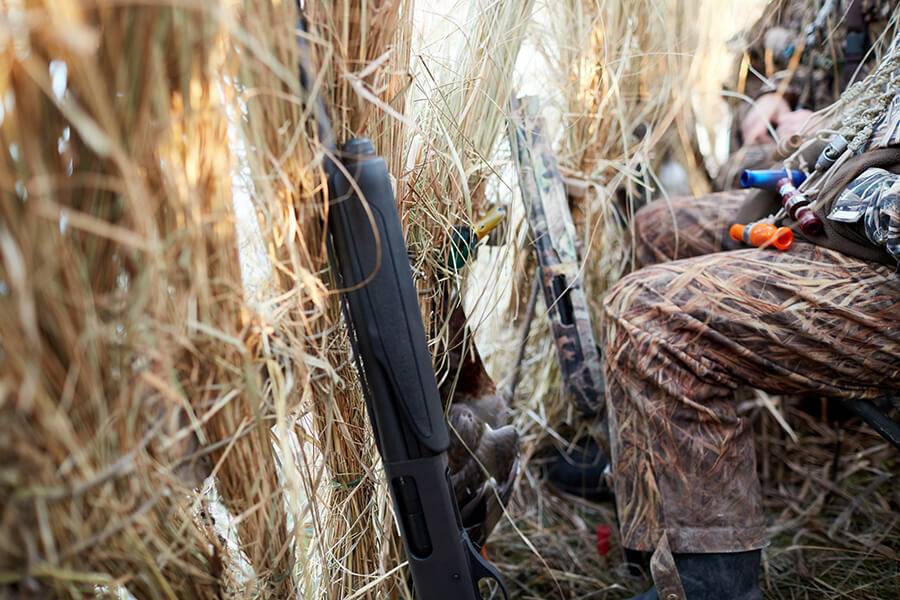Duck Blind Tips and Tricks

Duck Blind Tips and Tricks
Ask any seasoned waterfowl hunter about the importance of a quality, well camouflaged blind and the general consensus will hold it in very high regard. Sure, in some cases you can get away with minimal cover but for the most part, especially if the birds have the slightest bit of pressure, a blind can make or break a hunt.
There really isn’t a “one size fits all” in terms of blind building. Many folks prefer to use a boat with either a store bought or custom blind while others will build their own using the natural vegetation present. I generally fall into the latter grouping. Just be sure to read the DNR regulations on blinds to know what you can and cannot do. There are a few things I’ve learned over the years that have definitely helped in terms of readiness, function and effectiveness when it comes to building and hunting out of blinds.
Equipment
One tool that I always keep in my waterfowl pack that gets a lot of use is a folding limb saw. While Iowa regs state that you cannot cut down trees or use parts of trees when building a blind, this saw is an excellent tool for cutting down willows, which you are allowed to use. Willows make for great framework on a natural blind and can also be used to hold grass and vegetation up around a boat blind to further conceal it.
Another tool that has become invaluable amongst my group of hunting buddies is a cordless hedge trimmer. The days of ripping out grass and other vegetation by hand and tearing up gloves and fingers are now over. You can even make quick work on small willows. This tool has quite literally cut our blind building time in half. If you are hiking into a spot this might not be the most convenient thing to carry along with all of the other gear but if you have a boat or a spot to drive close to, a hedge trimmer can be an extremely helpful piece of equipment to bring along.
A third piece of equipment I have found to be very handy is military camo netting. These panels come in a couple of sizes and colors and are relatively inexpensive, super lightweight and durable. My boat does not have a blind on it and its primary use outside of fishing is to haul hunters, decoys and other gear to the hunting spots.
I’ll then park it down the shore a ways and use these panels to drape over it. The boat itself is all camo but the camo netting further helps to make it less conspicuous. These panels also work great as a base layer of concealment on a shoreline blind before adding grass and vegetation. They are also a nice addition to pop-up and hard sided boat blinds.
Considerations
Arguably the biggest and most obvious consideration when utilizing a blind is making sure to look like the surrounding landscape. I see this commonly on boat blinds where the camo is a totally different color than what is around it and they are pretty easy to pick out. If possible, it really pays to freshen up the blind with natural vegetation from the area you are hunting. Like mentioned before, a cordless hedge trimmer can make short work in this situation.
Another big one goes back to the old saying, “there are no right angles in nature”. If you think about it, it’s absolutely correct. Nothing sticks out more than a box shaped object along the reeds or shoreline. If you can spot it easily from a few hundred yards away, so can the waterfowl. A lot of boat blinds are in fact, quite box shaped. One way to mitigate this is to use willows to extend the body lines of the blind in the front and back, out at angles. You can then add in grass or vegetation to drape over the willows.
Try to imagine what approaching waterfowl are seeing from above. One color that really sticks out and can raise a red flag would be black. This happens when you have open gaps in the top of the blind, especially with boat blinds. A lot of folks are good about keeping overhead cover on their blinds but it is definitely something to be conscious of, even with natural shoreline blinds.
Final Thoughts
When it comes to boat blinds, there are many different options out there to accomplish hiding everything. Manufactured blinds are a good option but far less customizable. Lots of hunters like to make their own blinds and the material to do so range from conduit, wood, PVC, you name it. In my experience, strength and weight are critical in terms of a custom build. Obviously you want the blind to be strong so using lighter metals will accomplish this if you have the tools to work with them. Weight is a big deal as well in terms of safety and how much other gear you can haul and still have good mobility and speed with the vessel.
As far as building blinds go, a book could be written about all of the different options. It really comes down to the users discretion and what works for you. Looking natural with the surrounding landscape and eliminating right angles and dark holes makes a huge difference. Along with the equipment mentioned, I have found this to help me out tremendously in putting a few more birds in the bag. Have a great safe season ahead.
By Nick Johnson
October 2023


